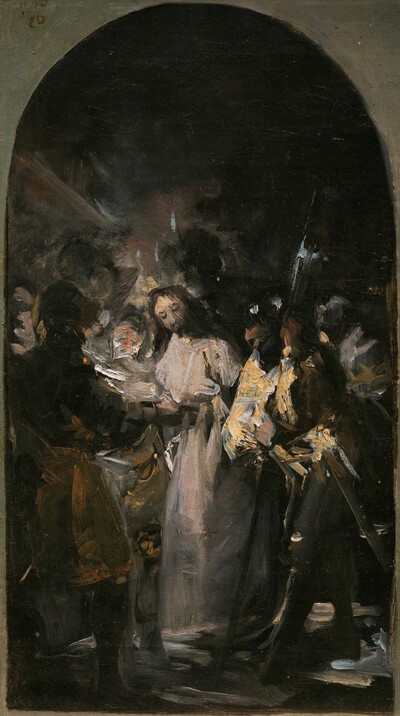- Cronología
- 1798
- Ubicación
- Toledo Cathedral , Toledo, Spain
- Dimensiones
- 300 x 200 cm
- Técnica y soporte
- Oil on canvas
- Reconocimiento de la autoría de Goya
- Documented work
- Titular
- Chapter of the metropolitan cathedral of Toledo
- Ficha: realización/revisión
- 26 Jan 2011 / 13 Jun 2023
- Otros títulos:
-
The Betrayal of Judas (La traición de Judas)
In around 1788 Goya received the commission for this painting from the Bishop of Toledo, as we know from the letter he wrote to his friend Martín Zapater on 2 June 1788. In the letter, he says that he had not even had time to produce a sketch for this work, although he goes into no further details. It seems that the commission he refers to was the Arrest of Christ (there are no details of any other work that Goya could have carried out for this cathedral) and that it was delayed for some years, a fact confirmed when Sánchez Cantón published the minutes of a meeting held at the San Fernando Academy on 6 January 1799, in which it is recorded that Goya presented the commission there. Two days later it was hung in the sacristy of Toledo Cathedral, where it has remained ever since.
Goya knew that the work was going to be lit by the candles which stood on the altar below the painting, as well as those which stood on the altar of the El Greco painting The Disrobing of Christ which dominates the sacristy of Toledo Cathedral. Aware that the upper part of the canvas would be obscured by the gloom of the sacristy, illuminated only by a small window and the candles, he placed the focal point of the action in the lower part of the canvas. The scene is constructed around the crowd of people and, above all, the heads which surround Christ. He is placed in the centre of the canvas, directly lit up by the lamp held by someone positioned behind Judas, who has the light behind him. The Messiah's robe attracts the eye, contrasting with the soldiers' clothing.
The grouping of the figures echoes that of The Disrobing of Christ, as if Goya wished to compete with the other artist. The play of light is reminiscent of Rembrandt. Above all, in this work we find elements which Goya would return to in later years, such as the lantern, here an omen of death, which inevitably reminds us of the lanterns of his Third of May (rec. no.?), or the deformed, unpleasant grimaces of those who surround the pained face of Christ, as if they themselves were a crown of thorns, and a clear predecessor of the Black Paintings. The contrast between bad and good characters is a sign of Goya's Romanticism, which he would employ on other occasions.
The Arrest is a dramatic work, very Goyaesque in nature, with those sketched touches which maintain the tension of the subject. Without a doubt, this is one of the most representative religious works of Goya's oeuvre, even of his work as a whole.
-
Francisco de Goya. IV Centenario de la capitalidadorganized by Ayuntamiento de Madrid and Dirección General de Bellas Artes at the Casón del Buen RetiroMadrid1961consultant editor Valentín de Sambriciocat. LXX
-
GoyaKoninklijk Kabinet van Schilderijen MauritshuisThe Hauge1970organized by Ministerio de Estado y Asuntos Culturales and Réunion des Musées Nationaux, July 4th to September 13th 1970. Exhibited also at the Musée de l’Orangerie des Tuileries, Paris, October 25th to December 7th 1970, consultant editors Jeannine Baticle and A. B. de Vriescat. 25
-
El arte de GoyaMuseo de Arte Occidental de TokioTokyo1971from 16th 1971 to January 23th 1972. Exhibited also at the Kyoto Municipal Museum of Art, January 29th to March 15th 1972.cat. 18
-
Pabellón de la Santa SedeExposición Universal de SevillaSevilla1992
-
GoyaNationalmuseumStockholm1994consultant editors Juan J. Luna and Görel Cavalli-Björkman. From October 7th 1994 to January 8th 1995cat. 20
-
Goya en las colecciones españolasSala de Exposiciones del BBVAMadrid1995consultant editor Juan J. Luna. From December 14th 1995 to February 17th 1996cat. 32
-
Goya en tiempos de guerraMuseo Nacional del PradoMadrid2008consultant editor Manuela B. Mena Marqués, from April 14th to July 13th 2008cat. 18
-
Zaragoza2021
-
L'œuvre peint de Goya. 4 volsParís1928-1950p. 125, cat. 80
-
Vie et ouvre de Francisco de GoyaParísOffice du livre1970pp. 165, 194, cat. 736
-
BarcelonaPolígrafa1970vol. I, p. 304, cat. 398
-
L’opera pittorica completa di GoyaMilanRizzoli1974p. 113, cat. 363
-
Francisco de Goya, 4 vols.ZaragozaCaja de Ahorros de Zaragoza, Aragón y Rioja1980-1982vol. II, p. 66 y p. 175 (il.)
-
Cartas a Martín ZapaterMadridIstmo2003p. 278, nº 106
-
Goya en tiempos de guerraMadridMuseo Nacional del Prado2008pp. 164-165, cat. 18 y p. 167 (il.)
-
Goya. Traveler and artist of the Grand Tour (exp. cat.)ZaragozaGobierno de Aragón2021p, 226

